Arts & Culture
Nostalgia: With a View

Sitting on one of the best locations in Amara, James Linsey and Don Servillas’ home brings together modern architecture, classic design elements and traditional Filipino details.
Once James Linsey opened the oversized wooden double doors that led into his house, it was clear that the star of the morning would actually be the playful doberman that approached us curiously as we walked into the foyer. “I don’t really own this house. It’s actually Atlas’,” James jokes, referring to the dog who was then settling on the living room sofa.
James has had Atlas for almost as long as he’s had the house, which finished construction about three years ago. A retired lawyer from New York City, James decided to settle in the Philippines, where his husband Don Servillas is from. He especially fell in love with this particular piece of land—situated on a slight hill in Lilo-an’s Amara, which looks out to the municipality’s historic lighthouse.
“We call it the Parola House because almost every room has a view of the parola,” James shares, using the local term for lighthouse. The architecture of the house definitely takes advantage of the vista—the main living rooms are positioned towards the lighthouse, with large picture windows that frame the structure as a sort of living art piece.
The couple had worked with architect Jun Ruaya, although James had specifically wanted to take inspiration from Horace Gifford’s work on Fire Island, a small stretch of land off the coast of Long Island that had garnered popularity as a gay vacation destination in past decades. “The Architecture of Seduction,” James says, reading the title of the coffee table book which served as the moodboard for the house’s design. Wooden elements, textured details and streamlined shapes cover the inside pages of the book.
These features found their way into the Parola House in the square spaces of the layout, the high ceilings, linear details and the aforementioned scenic windows. “We really wanted a more American and modern style when it came to the architecture,” James explains. He adds that the high ceilings were particularly important to allow better ventilation and take advantage of the cool ocean breeze. “Most days, I don’t even have to turn the air conditioning on,” he says.
A feeling of spaciousness is certainly felt upon entering the house—the two-storey foyer feels even larger with sparse furnishings, a large staircase, vertical window detailing, and drop pendant chandeliers hanging from the ceiling. A small indoor garden is tucked beneath the stairs, while across it a wide white wall is punctuated with a large Sio Montera painting and a Barcelona chair sitting beneath it.
Sliding glass doors lead to the den which holds a sitting area and entertainment center, and offers a view of Amara’s sprawling grounds and the sea beyond. Further into the house is the open floorplan of the living, dining and kitchen areas, each tucked into their own nooks.
With its sleek gray counters and modern appliances (“I know—so American!” James laughs when I point to the dishwasher), the kitchen gets a visual boost with the patterned backsplash. “Those tiles were made for us in Morocco, and had to be shipped to New York and then shipped here in balikbayan boxes,” James relates with a laugh.
A similar challenge came when they had the Mies van der Rohe daybed shipped from Hong Kong, along with the Barcelona chair. “There was some delay in customs,” James shrugs. The rest of the furnishings were locally sourced, with James and Don working closely with Murillo for many of the pieces. “Their pieces are so good.”
Finding that balance of modern design and traditional Filipino elements was important to the couple in conceptualizing their home’s interiors, which James and Don had put together themselves. The dining table, for example, is made from one piece of Ironwood, shipped all the way from Surigao. “It’s Don’s hometown,” he adds.
The traditional design technique continues at the roof deck, whose walls are lined with woven panels. “These guys came in with all the materials, and they just wove it right here on the spot,” he relates. “I really liked the pattern, I felt it was very native.”
The roof deck is one of James’ favorite areas of the house. The third floor sanctuary that looks out to the lighthouse and its grounds features vertical gardens, and has a bar and dining area. I tell him it’s all very New York, and he laughs. “It’s so rare for people to have roof decks here,” James states. With a view like this, it seems all too appropriate.
In my opinion, though, the best room to admire the view is the master suite. Occupying the southeast corner of the house, the bedroom offers 180-degree views of the Mactan Channel and the lighthouse. The bed faces east, allowing its occupants to enjoy the early morning sun. “At around 5 or 6 in the morning, the view from here is just beautiful,” James shares.
Through a walk-in closet is the master bathroom, which certainly feels like the best corner to relax in. A window runs along the length of an entire wall, while sitting next to it is a marble bathtub. “It’s from China, and it’s carved from a single block of Carrara marble,” James shares. The slate gray walls are decorated with capiz-framed mirrors and a ceiling lamp from Murillo.
James’ enthusiasm as he shows us around the house is palpable, and who could blame him? The home that he and Don have built for themselves is chic and comfortable, bringing together remarkable design elements while maximizing some of the best views in the area. “I hardly go into the city,” James admits, adding that he flies back and forth between New York City and Cebu. “I fly there usually about twice a year, maybe in the summer, but probably eight months of the year, I’ll be here.”
“It’s all very functional,” James continues to describe the house. “We wanted rooms that we would really use.” Perhaps that’s really what gives this house its appeal—although the details and fixings are thoughtful and luxurious, it still feels lived in and relaxed. Nothing in the space is there simply for show, and its habitability is something that will continue to draw guests and its residents—Atlas included—in.
Arts & Culture
Visayas Art Fair Year 5: Infinite Perspectives, Unbound Creativity
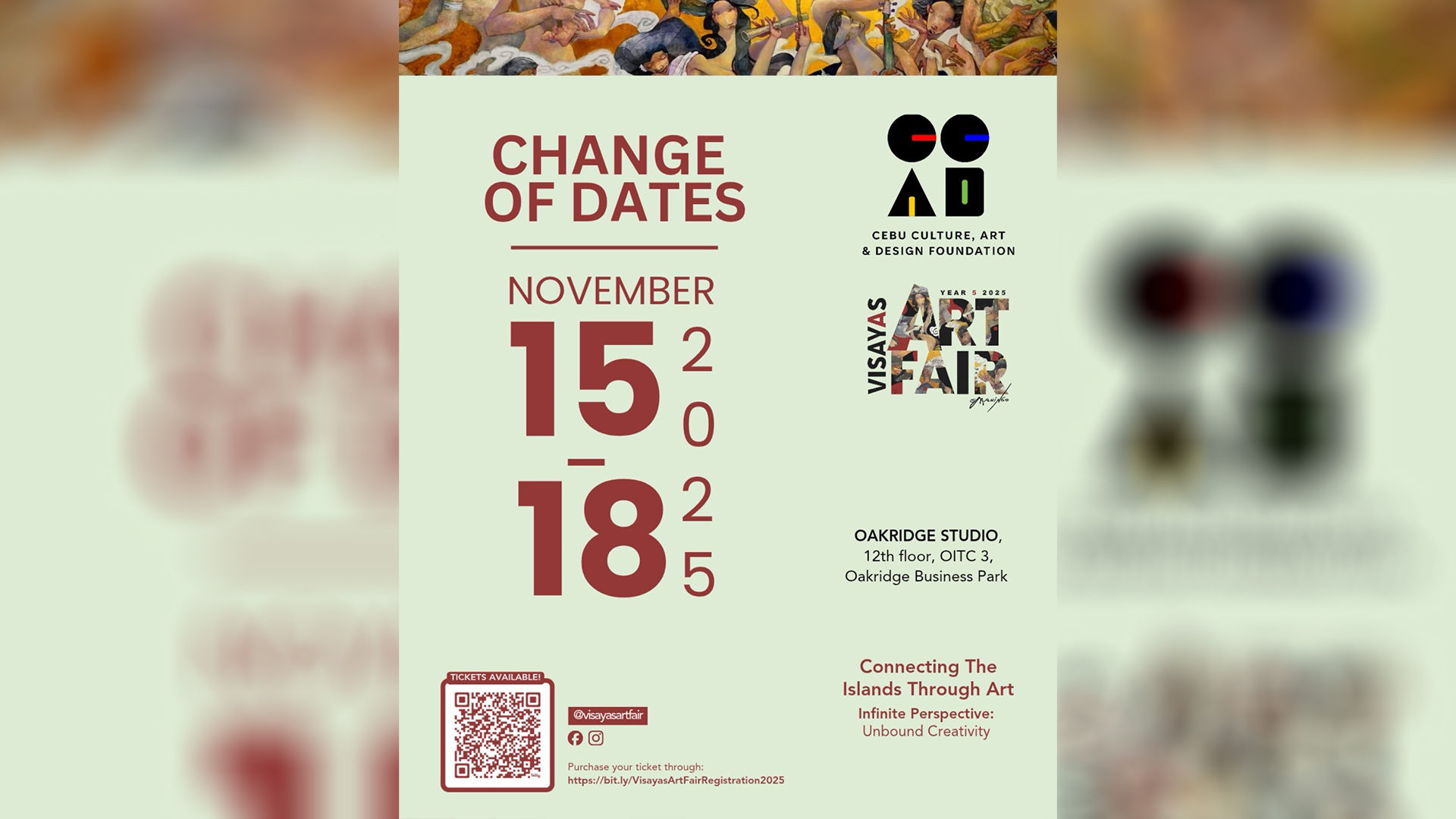
by Jing Ramos
This year’s Visayas Art Fair marks its 5th anniversary, celebrating the theme “Infinite Perspectives: Unbound Creativity.” The fair continues its mission of bridging creativity, culture, and community in the country. This milestone edition strengthens its partnership with the National Commission for Culture and the Arts and expands collaborations with regional art organizations and collectives—reinforcing its role as a unifying platform for Philippine art.
VAF5 features the works of Gil Francis Maningo, honoring the mastery of his gold leaf technique on opulent portraits of the Visayan muse Carmela, reflecting spiritual awareness.

Gil Francis Maningo is celebrated for his gold leaf technique.
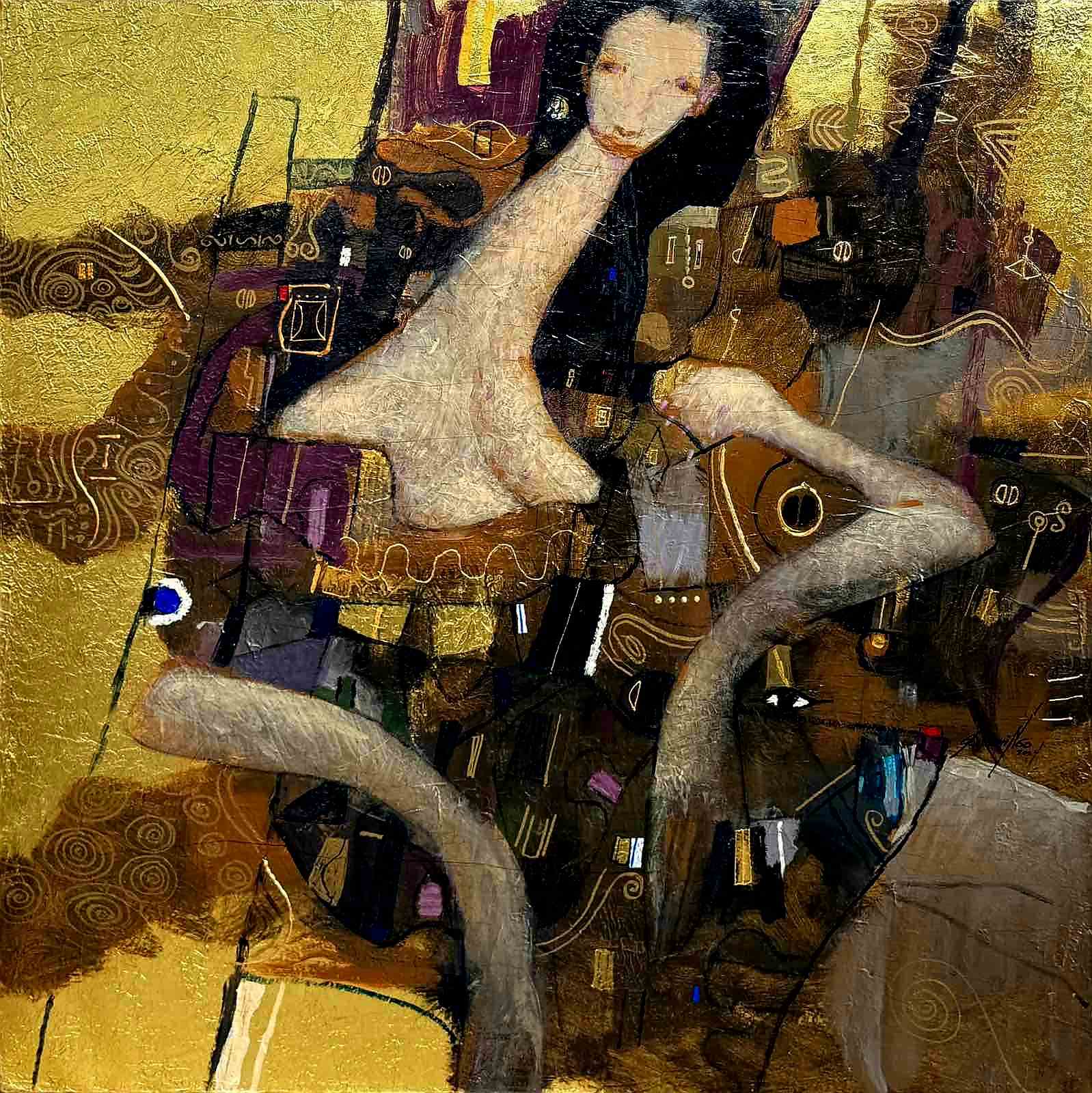
Gil Francis Maningo’s recurring theme of his Visayan muse “Carmela”.
Another featured artist is Danny Rayos del Sol, whose religious iconography of Marian-inspired portraits offers a profound meditation on the sacred and the sublime. This collaboration between two visual artists sparks a dialogue on the Visayan spirit of creativity and resilience. Titled “Pasinaya,” this dual showcase explores gold leaf as a medium of light and transcendence.
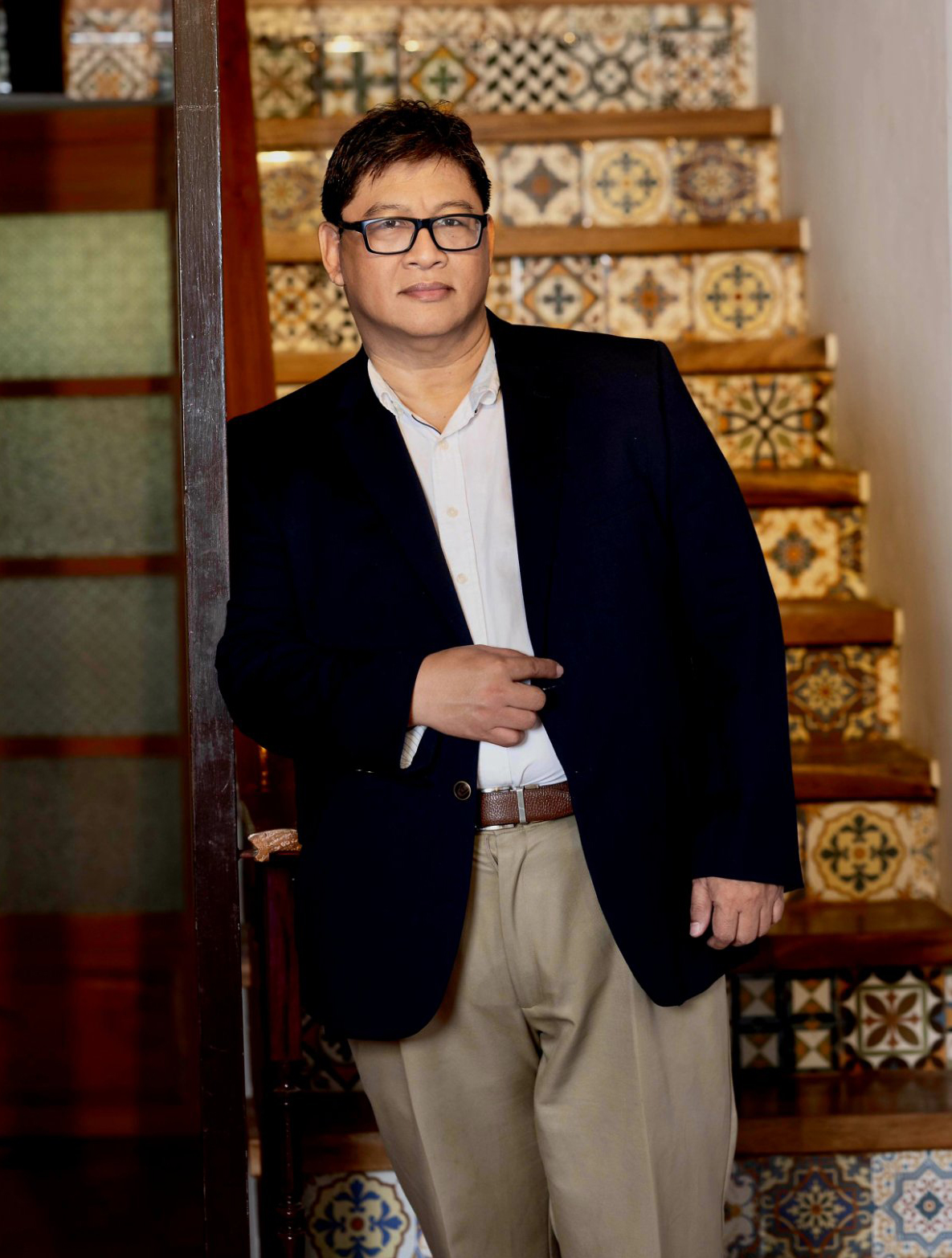
Artist Danny Reyes del Sol
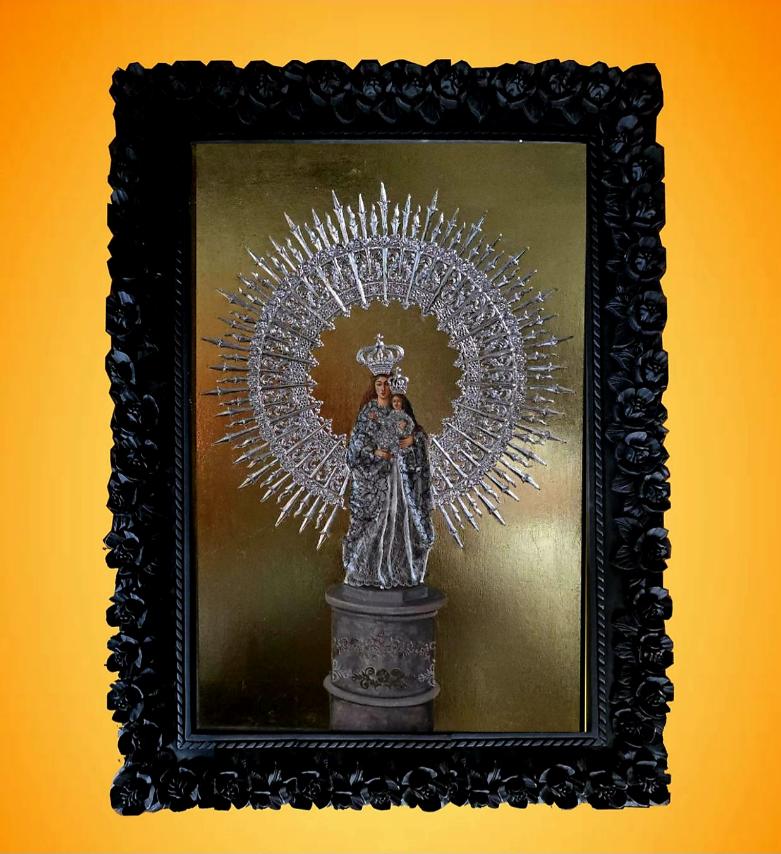
Danny Reyes del Sol’s religious iconography.
Now in its fifth year, the Visayas Art Fair has influenced a community of artists, gallerists, brokers, collectors, museum curators, and art critics—constructing a narrative that shapes how we approach and understand the artist and his work. This combination of factors, destined for popular consumption, illustrates the ways in which art and current culture have found common ground in a milieu enriched by the promise of increased revenue and the growing value of artworks.
Laurie Boquiren, Chairman of the Visayas Art Fair, elaborates on the theme, expressing a vision that celebrates the boundless imagination of unique artistic voices:
“Infinite Perspectives speaks of the countless ways artists see, interpret, and transform the world around them—reminding us that creativity knows no single point of view. Unbound Creativity embodies freedom from convention and controlled expression, allowing every artist to explore and experiment without borders.”

Laurie Boquiren, Chairman of the Visayas Art Fair has tirelessly championed the creative arts for the past five years.
Arts & Culture
Kultura. Kapital. Kasalukuyan: Art that Speaks of Today
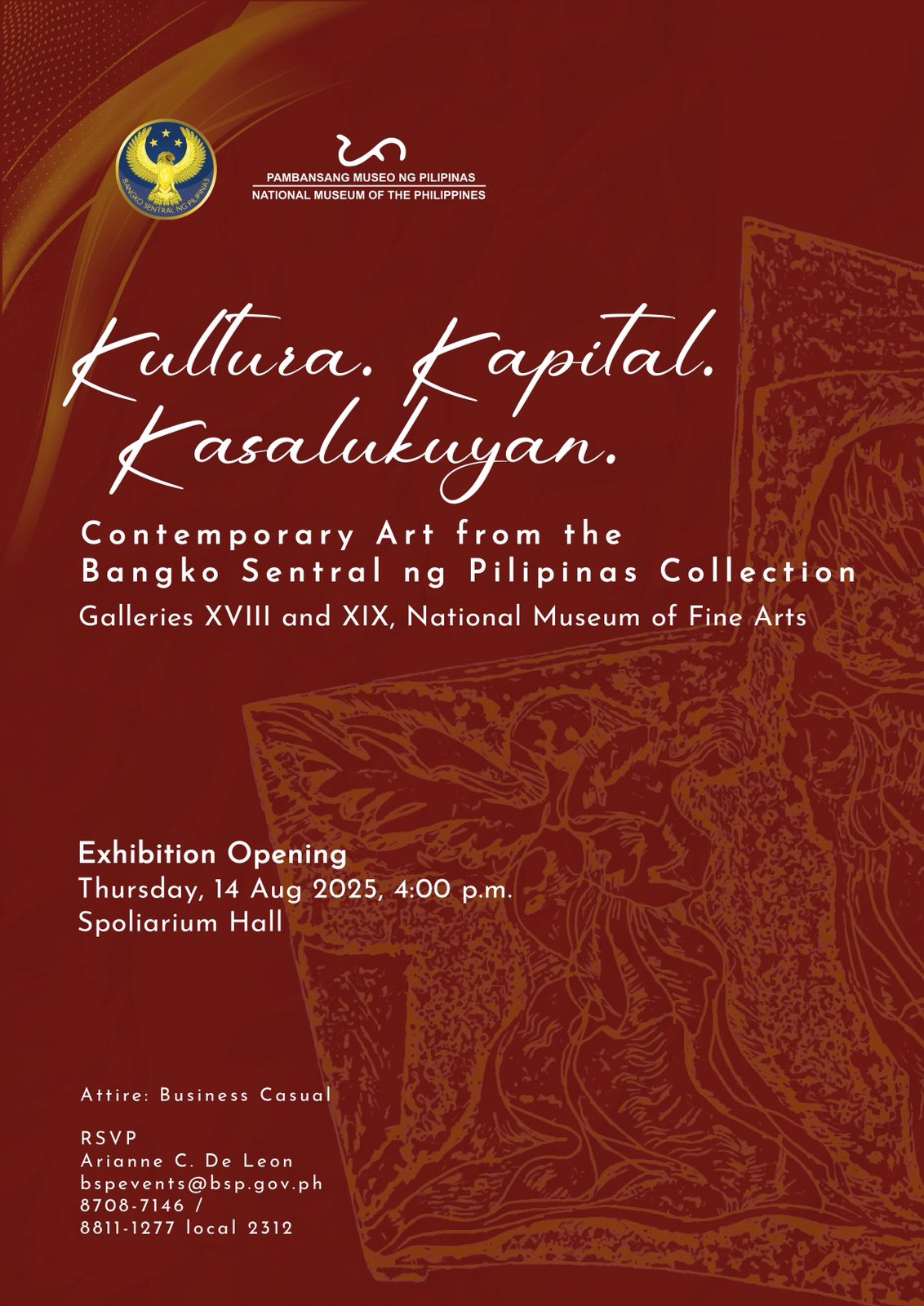
by Jose Carlos G. Campos, Board of Trustees National Museum of the Philippines
The National Museum of the Philippines (NMP) and the Bangko Sentral ng Pilipinas (BSP) recently teamed up to prove that money isn’t just for counting—it’s also for curating! Their latest joint exhibition, Kultura. Kapital. Kasalukuyan: Contemporary Art from the Bangko Sentral ng Pilipinas Collection, is now open, and it’s a real treat for art lovers and culture buffs alike.
On display are gems from the BSP’s contemporary art collection, including masterpieces by National Artist Benedicto Cabrera (Bencab), along with works by Onib Olmedo, Brenda Fajardo, Antipas Delotavo, Edgar Talusan Fernandez, and many more. Some of the artists even showed up in person—Charlie Co, Junyee, Imelda Cajipe-Endaya, Demi Padua, Joey Cobcobo, Leonard Aguinaldo, Gerardo Tan, Melvin Culaba—while others sent their family representatives, like Mayumi Habulan and Jeudi Garibay. Talk about art running in the family!
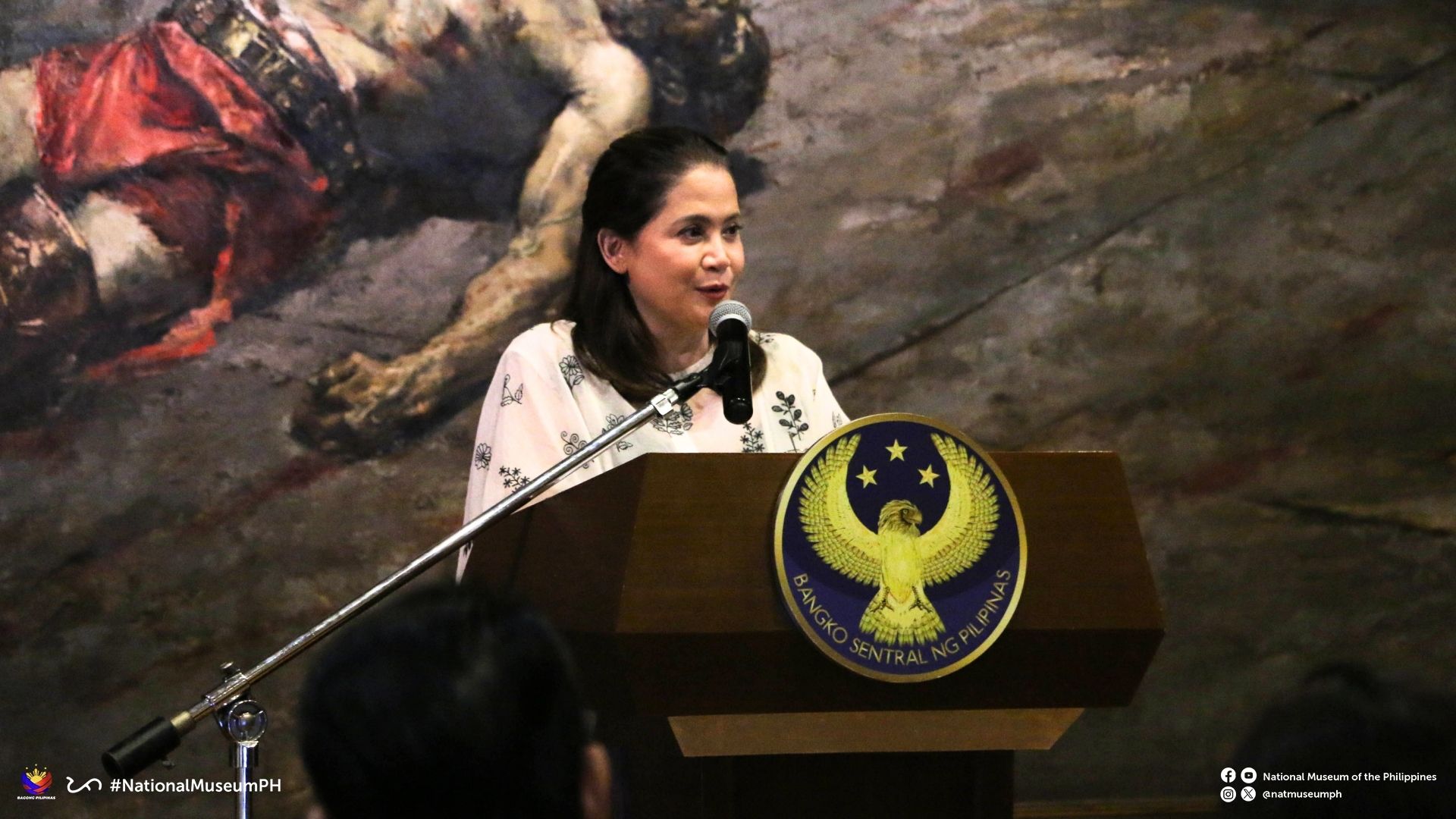
Deputy Governor General of the BSP, Berna Romulo Puyat
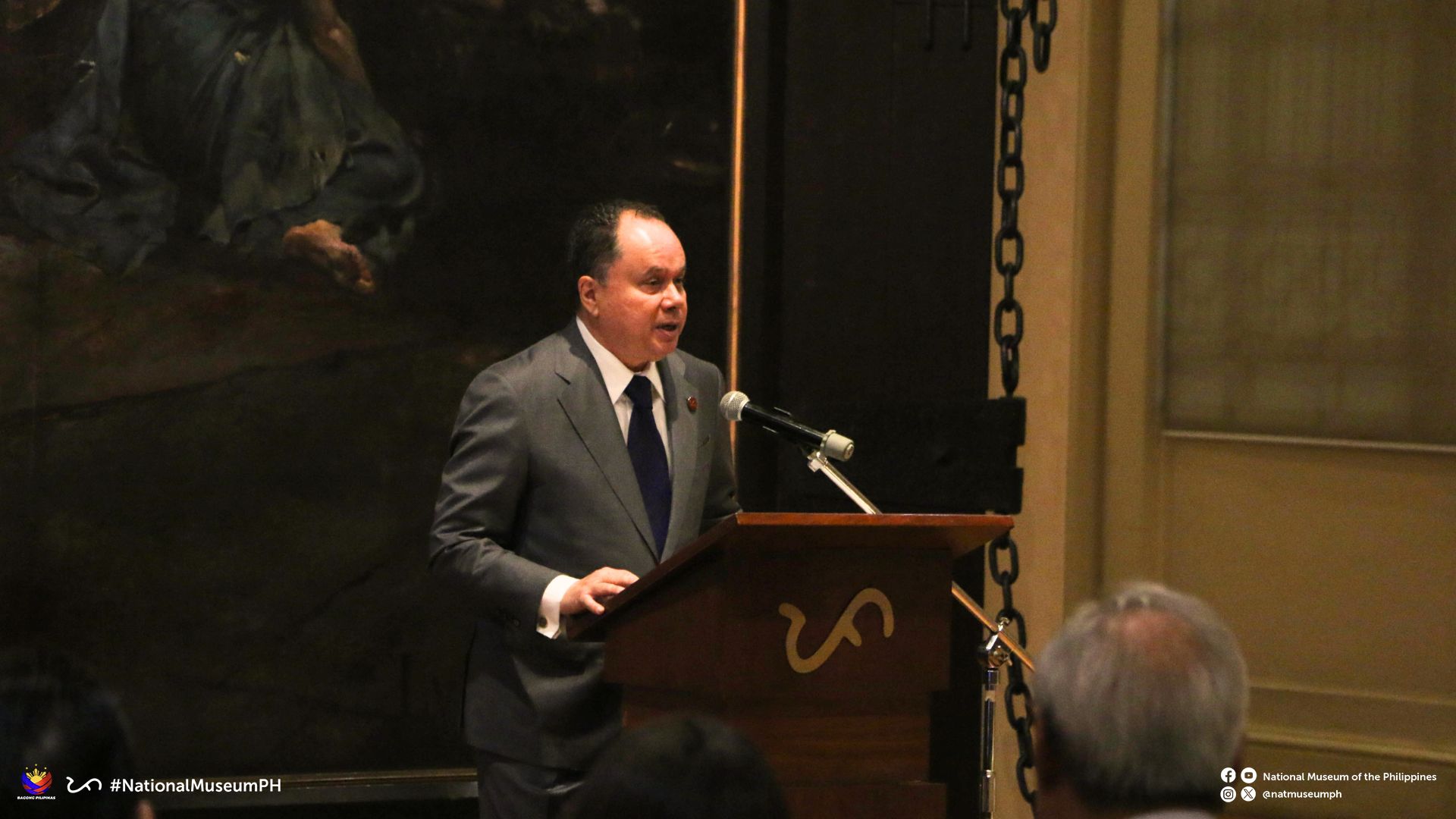
Chairman of NMP, Andoni Aboitiz
The BSP Governor Eli M. Remolona, Jr. and members of the Monetary Board joined the event, alongside former BSP Governor Amando M. Tetangco, Jr., Ms. Tess Espenilla (wife of the late Nestor A. Espenilla, Jr.), and the ever-graceful former Central Bank Governor Jaime C. Laya, who gave a short but enlightening talk about the BSP art collection.
From the NMP, Chairman Andoni Aboitiz, Director-General Jeremy Barns, and fellow trustees NCCA Chairman Victorino Mapa Manalo, Carlo Ebeo, and Jose Carlos Garcia-Campos also graced the occasion. Chairman Aboitiz expressed gratitude to the BSP for renewing its partnership, calling the exhibition a shining example of how financial institutions can also enrich our cultural wealth.
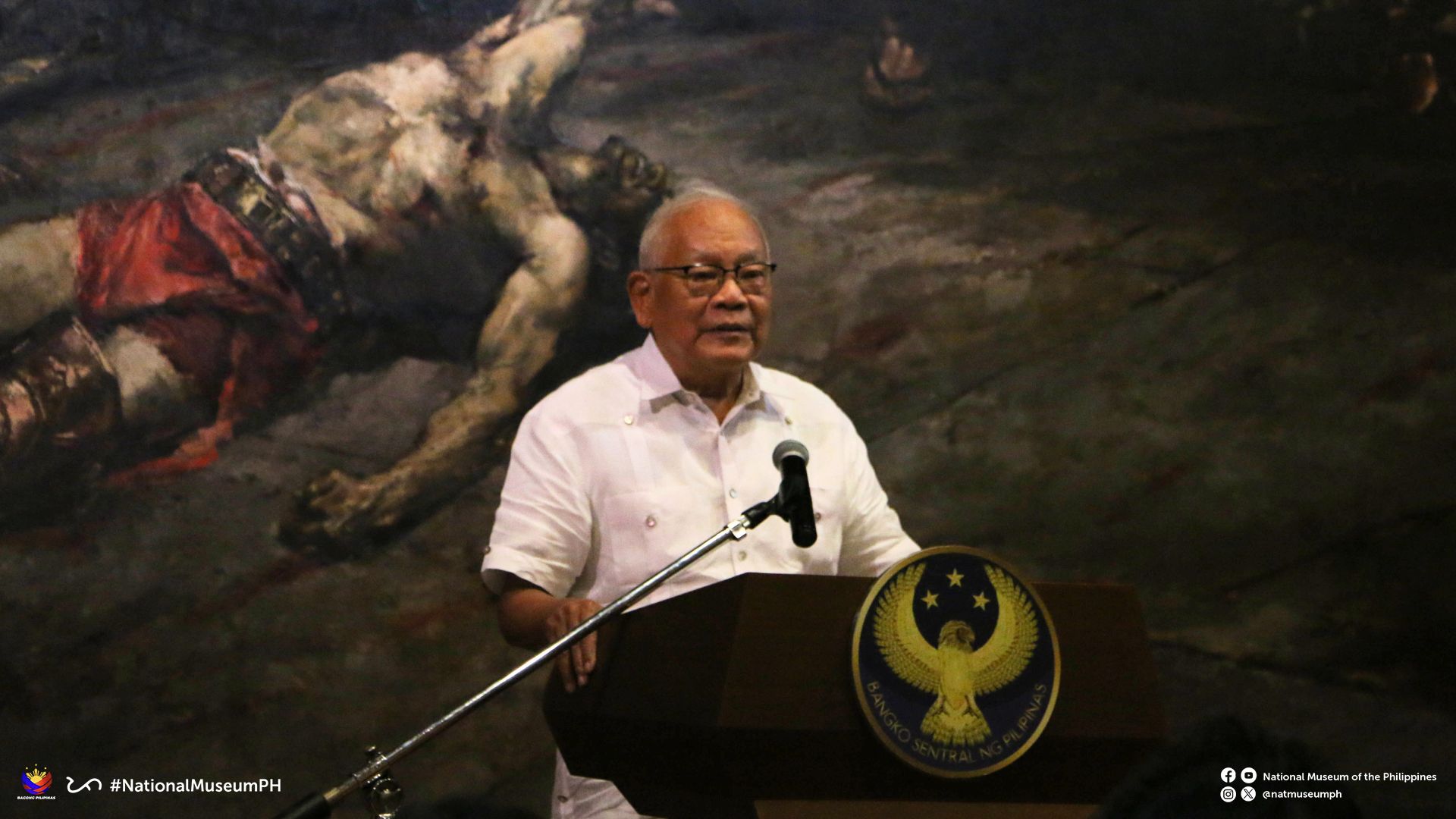
Former Governor of BSP Jaime Laya
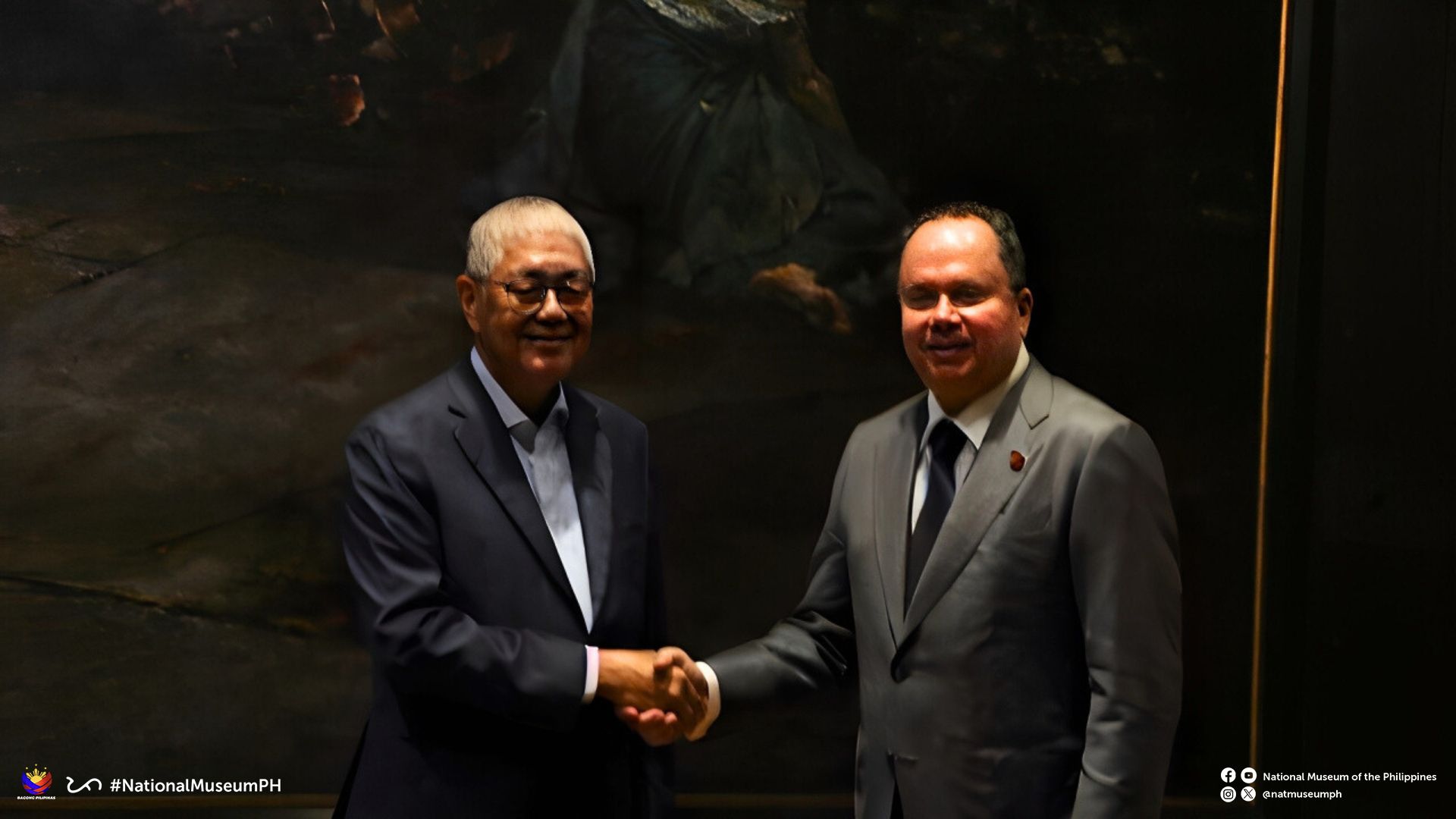
Governor of BSP Eli M. Remona and Chairman of NMP Board Andoni Aboitiz
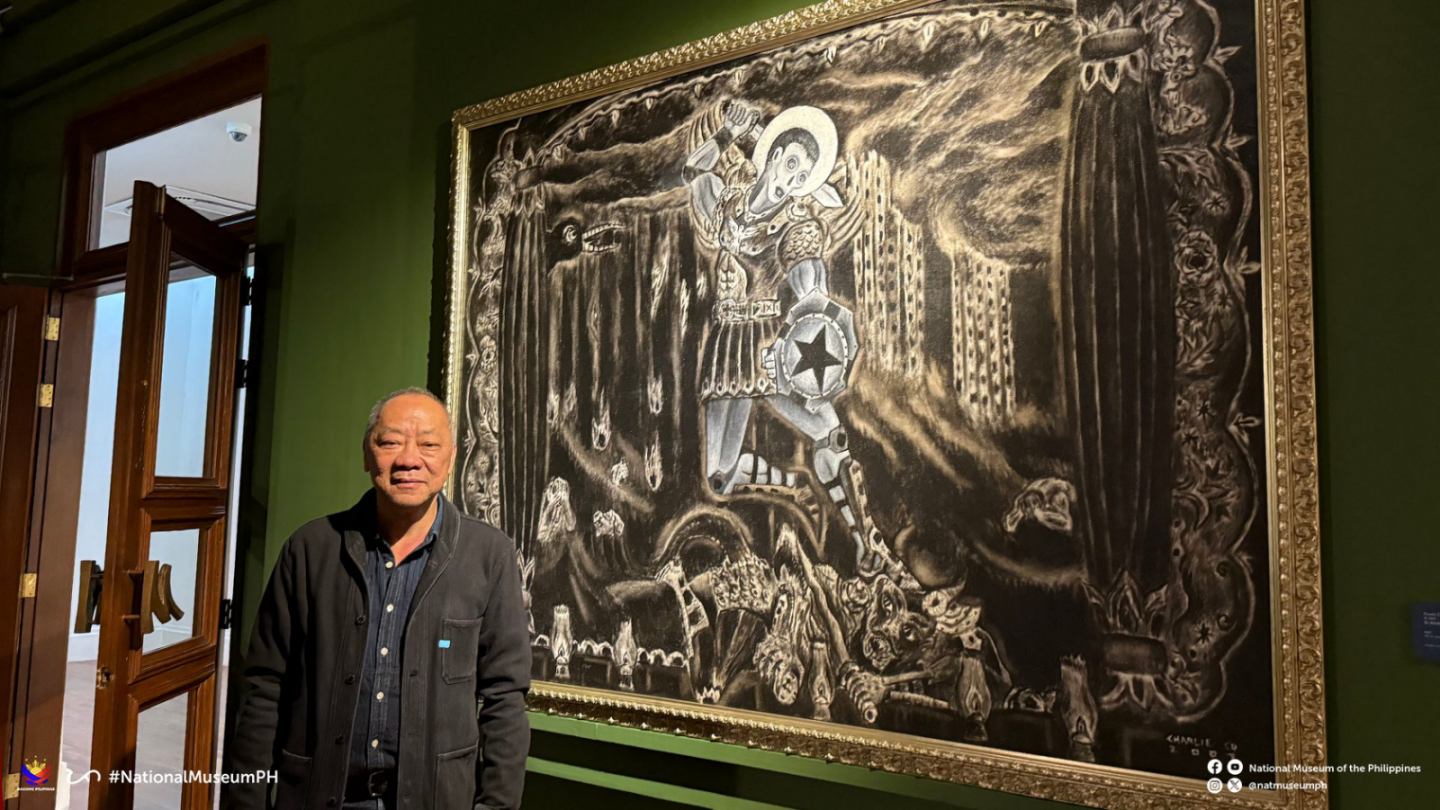
Artist Charlie Co
Before the official launch, a special media preview was held on 5 August, hosted by BSP Deputy Governor Bernadette Romulo-Puyat and DG Jeremy Barns. It gave lucky guests a sneak peek at the collection—because sometimes, even art likes to play “hard to get.”
The exhibition Kultura. Kapital. Kasalukuyan will run until November 2027 at Galleries XVIII and XIX, 3/F, National Museum of Fine Arts. Doors are open daily, 9:00 AM to 6:00 PM. So if you’re looking for something enriching that won’t hurt your wallet (admission is free!), this is your sign to visit. After all, the best kind of interest is cultural interest.
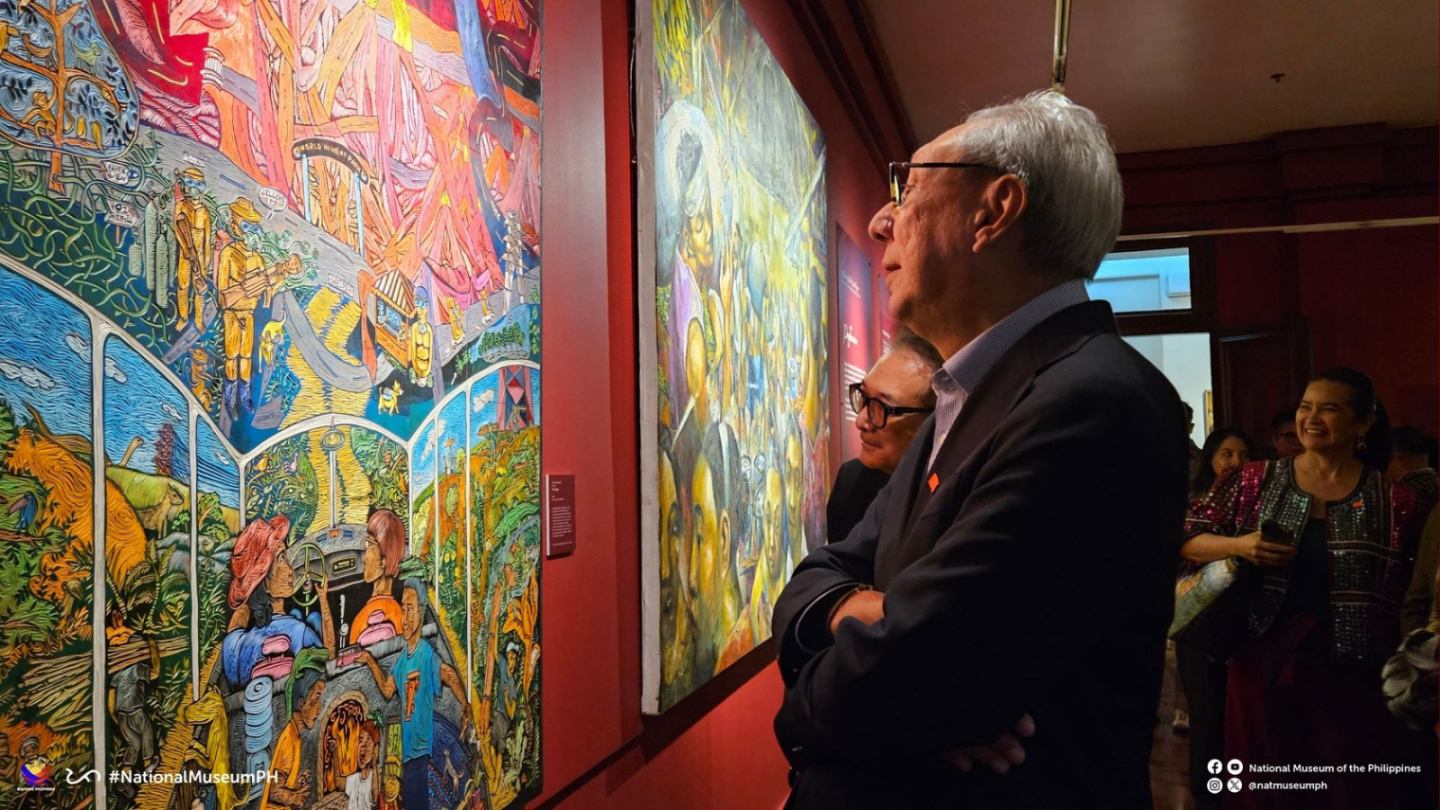
Monetary Board of the BSP, Walter C. Wassmer
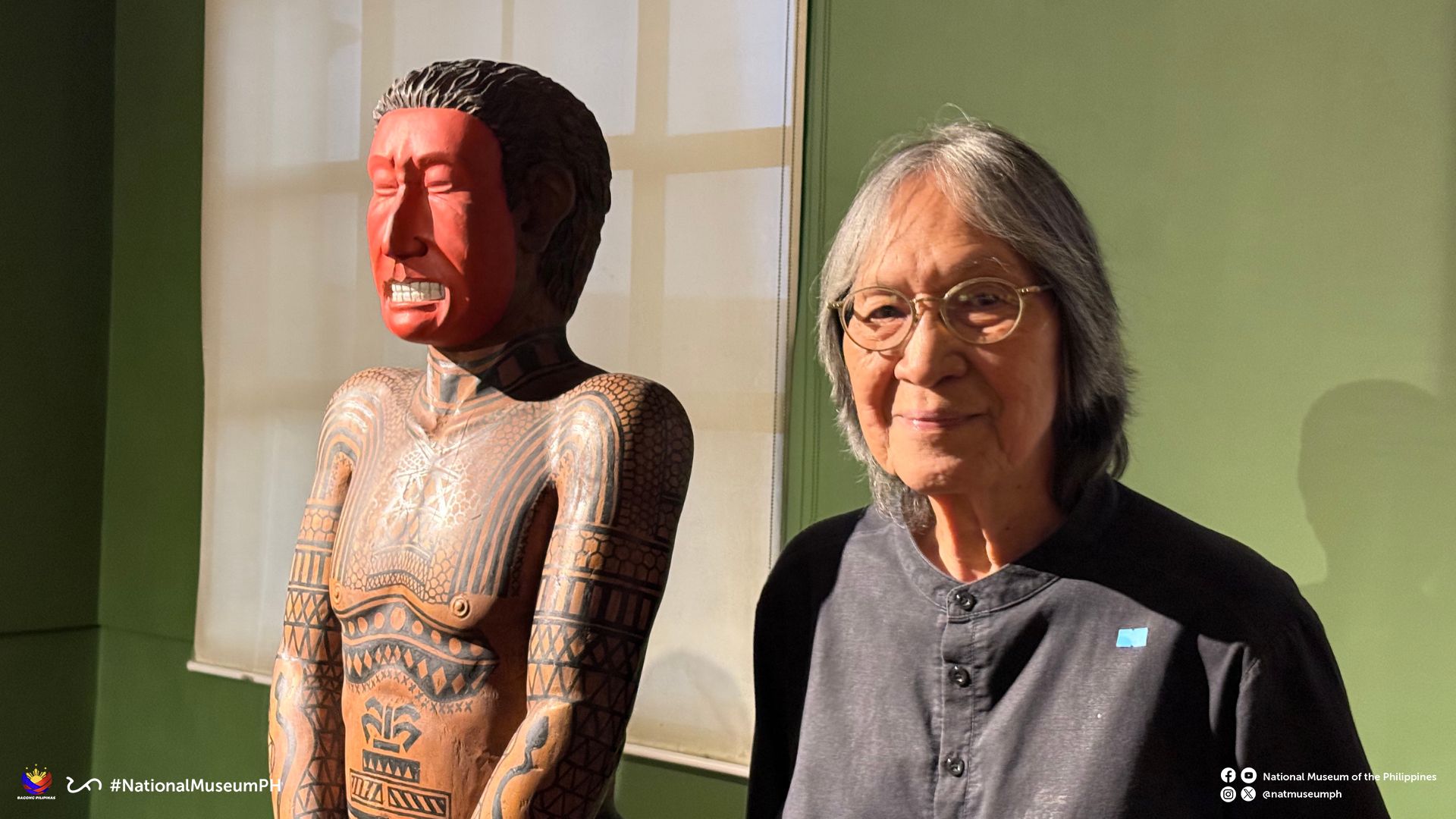
Luis Yee, Jr. aka ‘Junyee’ The Artist beside his Sculpture
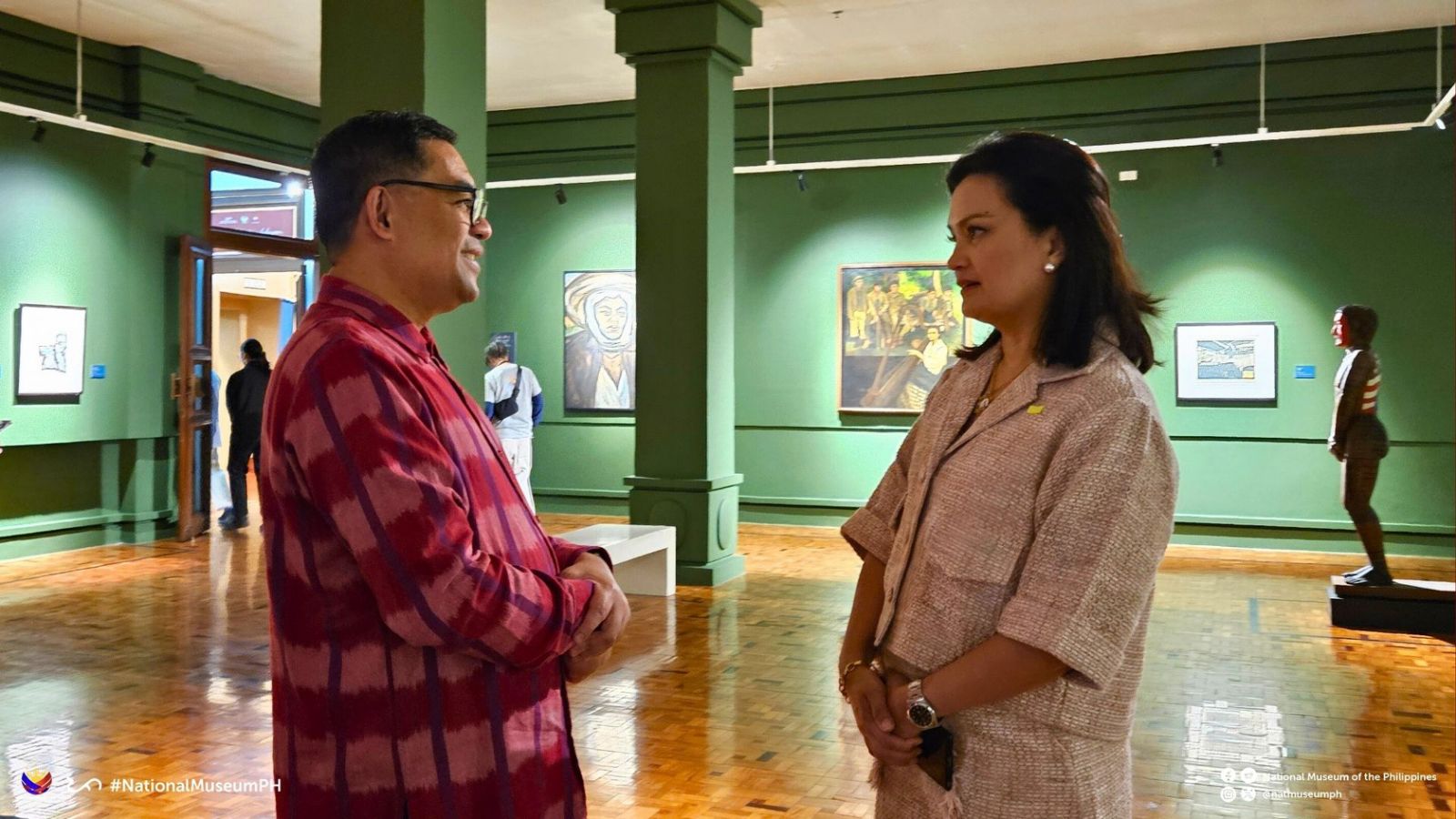
Arvin Manuel Villalon, Acting Deputy Director General for Museums, NMP with Ms. Daphne Osena Paez
Arts & Culture
Asia’s Fashion Czar I Knew as Tito Pitoy; Remembrance of a Friendship Beyond Fashion with Designer Jose R. Moreno
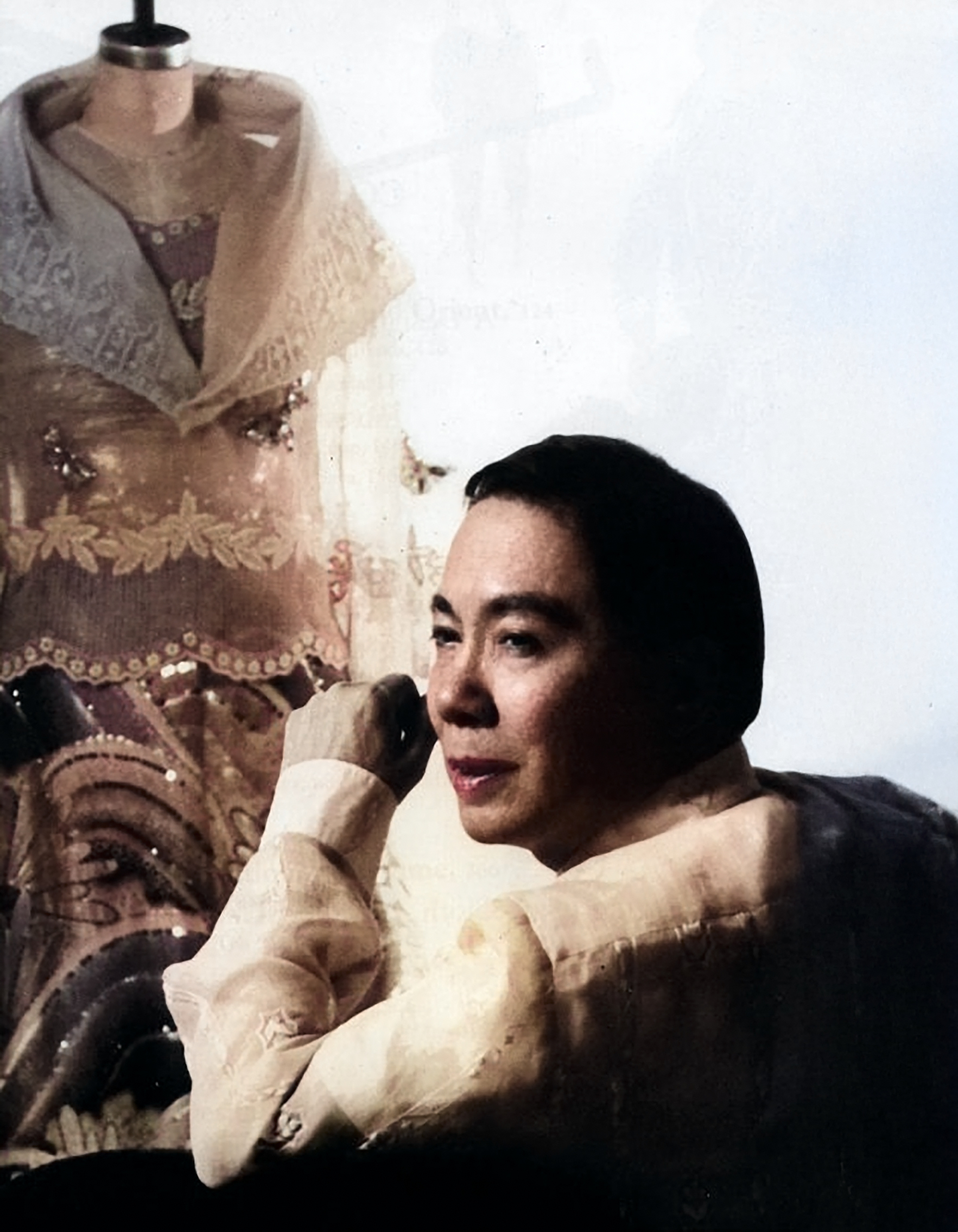
by Jose Carlos G. Campos, Board of Trustees National Museum of the Philippines
My childhood encounter with the famous Pitoy Moreno happened when I was eight years old. My maternal grandmother, Leonila D. Garcia, the former First Lady of the Philippines, and my mother, Linda G. Campos, along with my Dimataga aunts, brought me to his legendary atelier on General Malvar Street in Malate, Manila. These were the unhurried years of the 1970s.
As we approached the atelier, I was enchanted by its fine appointments. The cerulean blue and canary yellow striped canopies shaded tall bay windows draped in fine lace—no signage needed, the designer’s elegance spoke for itself. Inside, we were led to a hallway adorned with Art Deco wooden filigree, and there was Pitoy Moreno himself waiting with open arms—”Kamusta na, Inday and Baby Linda,” as he fondly called Lola and Mommy.
“Ahhh Pitoy, it’s been a while,” Lola spoke with joy.
“Oh eto, may kasal na naman,” my mom teasingly smiled.
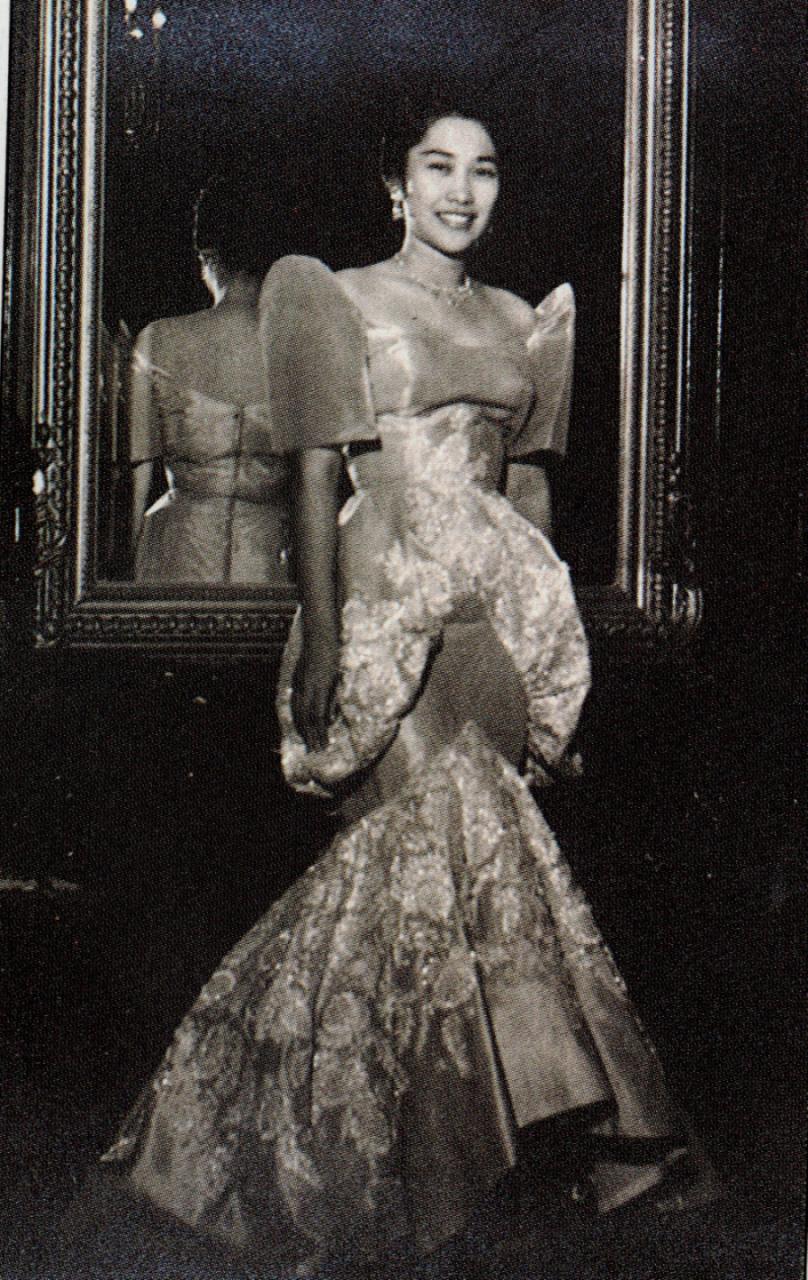
Linda Garcia Campos and Pitoy Moreno’s friendship started when they were students in the University of the Philippines in Diliman.
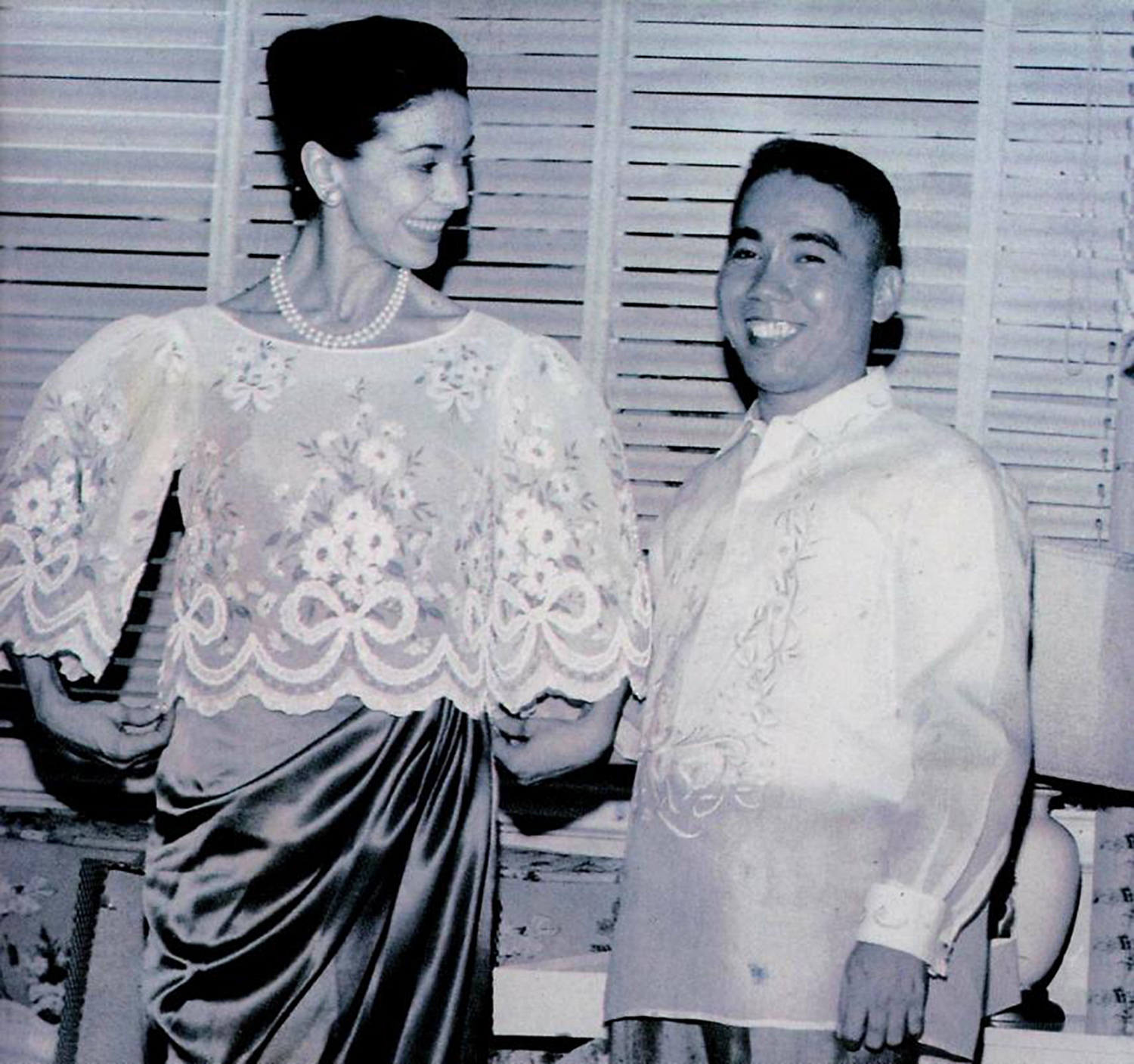
When Dame Margot Fonteyn came for a visit to Manila, Pitoy Moreno dressed her up for an occasion.
We had entered a world of beauty—porcelain figurines, ancient earthenware and pre-colonial relics. It was like stepping into a looking glass, only Pitoy could have imagined.
Destiny led me back years later when my mother Linda told me that Pitoy Moreno was working on his second book, Philippine Costume, and needed research material and editorial advice. At this point, around the 1990s, I was in between assignments—unsure of how a broadcasting graduate like me could possibly contribute to a fashion icon’s masterpiece. Fortunately, I agreed to the project.
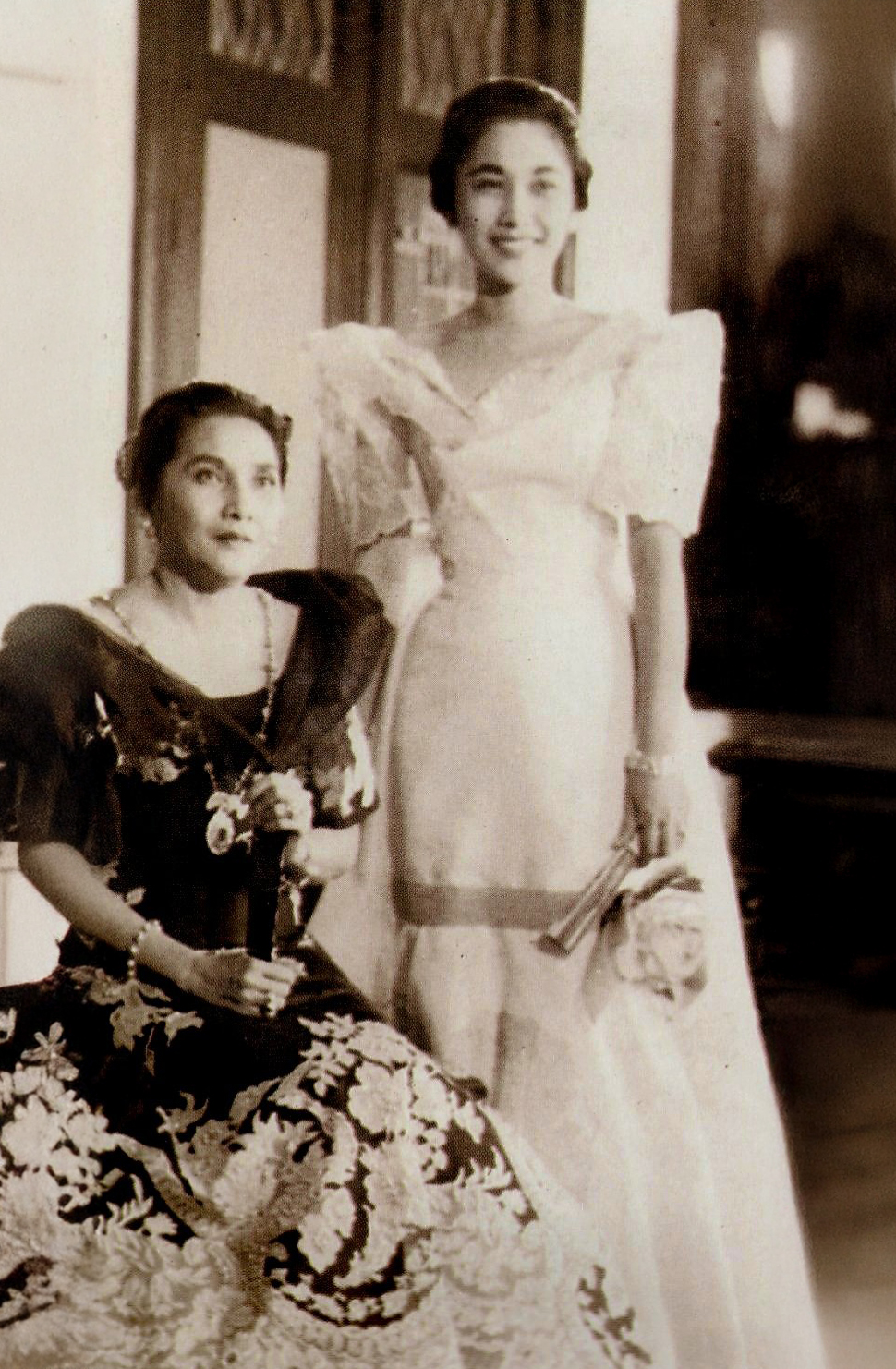
Former First Lady Leonila D. Garcia and daughter Linda G. Campos in Malacañang Palace.
Returning to the designer’s atelier brought back a rush of pleasant memories. The gate opened, and there stood Pitoy Moreno, beaming as always.
“Come in, hijo. Let me show you what I have in mind—and call me Tito Pitoy, okay?”
He led me to his worktable.
“I want to publish a book that tells the story of Philippine fashion—from our pre-colonial roots to the present. A designer’s collection of images and heritage expressed in clothing.”
I was awestruck. “How can I help you?” I inquired.
“Did you know that your mother, Linda, was my barkada in the University of the Philippines in Diliman?” he grinned.
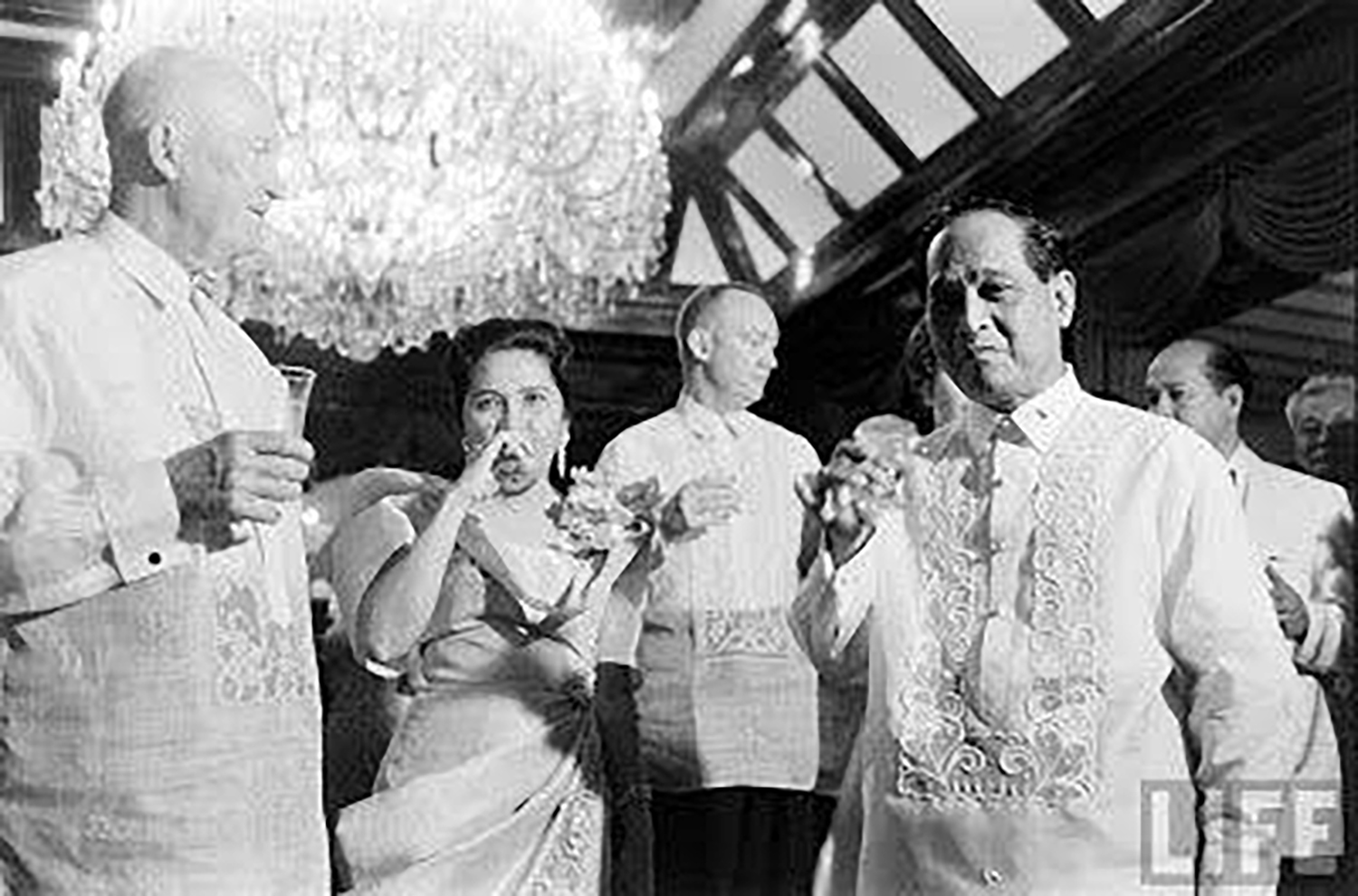
US President Dwight Eisenhower with First Lady Leonila Garcia and President Carlos Garcia in a state dinner at Malacañang Palace in Manila.
That friendship soon led to one of the proudest moments of the designer’s life. He had the opportunity to dress not only the First Lady Leonila D. Garcia but also President Carlos P. Garcia during his term. It was also during this time that the President of the United States, Dwight Eisenhower, came for an official visit to Manila. The designer was able to make clothes for the President, his daughter, and his staff.
“Eisenhower even asked for discounts on the barong Tagalog,” Tito Pitoy laughed.
Tito Pitoy then asked if I could find a terno he had made for my Lola, the former First Lady, which she wore for President Eisenhower’s state visit in 1960.
“How about her other ternos, dated from the 1920s to the 1960s?” I offered.
He lit up.
I scoured my Lola’s extensive closet—it felt like unearthing a legacy. Tucked behind layers of vintage ternos from countless fashion designers, I found that terno, which was photographed by Dick Baldovino along with other pieces for the book project. Once the project was finished and I myself had moved on, my bond with Tito Pitoy never wavered.
When my Lola passed away, he was deeply touched when I personally informed him of the sad news. Once, at the wake of former Vice President Salvador Laurel, he asked me to assist him in the placement of the medals in the chapel.

Philippine Costume by Jose Moreno is the designer’s collection of images and heritage expressed in clothing.
Tito Pitoy later invited me to his 80th birthday celebration—a dazzling Manila affair in 2012. During the evening’s festivities, he handed me a printed copy of Philippine Costume and added warmly,
“Thank you, hijo. I’ll call on you for the next one.”
The highlight of his career—and his most unforgettable moment—came during the Metro Magazine Gala fashion show: A Tribute to Pitoy Moreno, Fashion Icon. A collection of evening gowns spanning six decades—many of them unseen and tucked away in his atelier—were revealed that night. When the finale came, Tito Pitoy walked the stage, triumphant and waving to a sea of admirers. Longtime friends from the industry, society’s finest, and fashionistas rose from their seats and gave him a standing ovation.
It wasn’t just to celebrate his craft and ingenuity—it was to honor the man who brought elegance, history, and heart in every stitch.
-
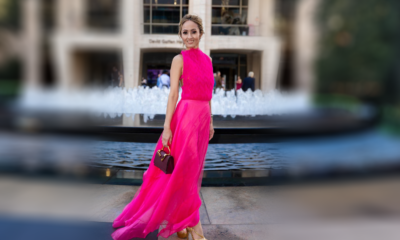
 Style2 months ago
Style2 months agoHappy Melendres Traipsing Around Manhattan in Non-Stop Armani
-

 Prime Target2 months ago
Prime Target2 months agoMiko Sarmiento: Turning Silk Scarves Into Works of Art
-
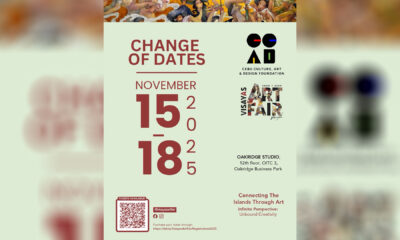
 Arts & Culture1 month ago
Arts & Culture1 month agoVisayas Art Fair Year 5: Infinite Perspectives, Unbound Creativity
-

 The Scene3 months ago
The Scene3 months agoAnother Elegant Dinner at Chez Marguerite
-

 Prime Target3 months ago
Prime Target3 months agoLuna Vdl–Endless Summers in Siargao
-

 QuickFx3 months ago
QuickFx3 months agoI Lost It at the Movies: Five of the Most Significant Films of the 1960s
-

 Travel1 month ago
Travel1 month agoAutumn in Istanbul: Fellow Travellers Share Turkish Delights
-
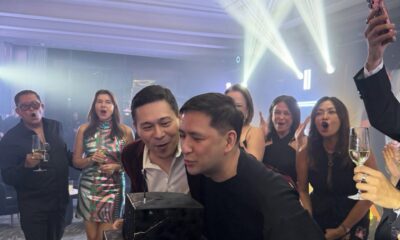
 The Scene4 weeks ago
The Scene4 weeks agoBe Fabulous: Dr. Fremont Base’s 50th Birthday Party Echoes the Disco-Glam Era










You must be logged in to post a comment Login